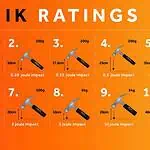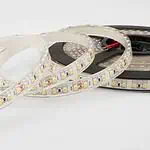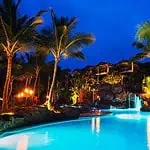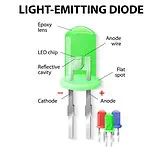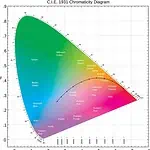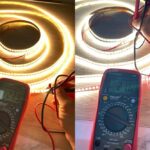Manufacturers often use the term “dust resistant” or “waterproof” to describe their products’ robustness. But such statements don’t give proper justification for the extent of protection. So, to specify and strengthen such claims, they use IP ratings to define the resistance level of their products. But what does IP rating mean?
Ingress Protection or IP rating is an International Standard EN 60529-defined rating system used to measure the degree of protection of any electrical devices against foreign bodies (dust, wires, etc.) and moisture (water). It is a two-digit grading system where the first digit denotes protection against solid ingress and the second digit for liquid ingress.
The IP rating is a significant factor when purchasing electronic devices, including light fixtures or LED strips. So, here I’ve presented a detailed guideline about various IP ratings and their suitable uses-
What Is IP Rating?
Ingress Protection or IP rating indicates the degree of protection of any electrical object from solid and liquid ingress. It usually consists of two digits. The first digit indicates protection from solids, and the second from the liquid. So, the higher the numbers after IP, the better the protection it provides. Yet, there can be a third letter describing more information about the level of protection. But this letter is often omitted.
So, to simplify, IP rating indicates the ability of a device to resist foreign particles like- dust, water, or unwanted contact. And this term applies to all electronic devices; Lights, Phones, Irons, TV, etc.
What Is IPX Rating?
The letter ‘X’ in the IP rating indicates that the device has not been rated for any specific protection level. So, for example, if X replaces the first digit of the IP rating, it indicates that the device has no data available on protection from solid ingress/dust. And if it replaces the second digit, the machine has no ratings for liquid ingress protection.
Thus, IPX6 means that an object can resist water spray but has yet to go through any test to clarify the rating for solid contact. And IP6X indicates just the opposite fact; it is safe from solid ingress, but no information is available for waterproofing.
What Does The Numbers And Letters In IP Rating Indicate?
The numbers and letters in the IP rating have a definite meaning. Each of the digits indicates a specific level of protection.
1st Digit:
The first digit of the IP rating specifies the level of protection from solid bodies like- dust, fingers, or any tools, etc. The degree of protection for solids is graded with X, 0, 1,2,3,4,5, and 6. Each digit indicates different protection properties.
| Effective Against | Protection Ingress |
| – | No data is available for specifying protection grade. |
| – | No protection against contact or ingress of solid |
| > 50 mm2.0 in | It is protected against larger body surfaces, but no protection if you intentionally touch it with a body part. |
| > 12.5 mm0.49 in | Protection against fingers or similar objects |
| > 2.5 mm0.098 in | Tools, thick wires, etc. |
| > 1 mm0.039 in | Most wires, slender screws, giant ants, etc. |
| Dust protected | Partial protection from dust; the dust can still enter |
| Dust-tight | Dust-tight. (No dust can enter. A fixture must withstand an eight-hour vacuum test.) |
2nd Digit:
The IP rating’s second digit describes how well an enclosure protects internal components from various types of moisture (sprays, drips, submersion, etc.). It is graded as X, 0, 1, 2, 3, 4, 5, 6, 6K, 7, 8, 9, and 9K. Similar to the first digit, they also define different degrees of protection.
| Level | Protection Against | Effective For | Description |
|---|---|---|---|
| X | – | – | No data available |
| 0 | None | – | No protection on liquids |
| 1 | Dripping water | Vertical water drop will not affect when mounted at an upright position on the turntable and rotated at 1 RPM | Test duration: 10 minutes. Withstand Water: 1 mm (0.039 in) rainfall per minute |
| 2 | Dripping water when tilted at 15° | Vertical dripping water will not affect when the fixture/object is tilted at 15 degrees from the normal position | Test duration: 10 minutes ( 2.5 min in each direction)Withstand water: 3 mm (0.12 in) rainfall per minute |
| 3 | Spraying water | Water spray (with a spray nozzle or oscillation tube) up to 60 degrees from the vertical direction will not affect the fixture. | For Spray Nozzle:Test duration: 1 min/sq.m for at least 5 minWater volume: 10 liter/minPressure: 50 -150 kPaFor Oscillating Tube:Test duration: 10 minWater volume: 0.07 liter/min |
| 4 | Splashing of water | Water splashing (with a no-shield spray nozzle or an oscillating fixture) from any direction will not cause any harm. | For Spray Nozzle without shield:Test duration: 1 min/sq.m for at least 5 minFor Oscillating Tube:Test duration: 10 min |
| 5 | Water jets | Water projection (with a 6.3mm nozzle) from any direction will not cause any harm. | Test duration: 1 min/sq.m for at least 3 minutes. Water volume: 12.5 liters/minPressure: 30 kPa at a distance of 3 meters |
| 6 | Powerful water jets | Strong jets of water (12.5 mm) directed from any angle shall not cause damage | Test duration:1 min/sq.m for at least 3 minutesWater volume: 100 liters/min Pressure: 100 kPa at a distance of 3 meters |
| 6K | Powerful water jet with high pressure | Strong water jets (6.3 mm nozzle) directed at the enclosure from any angle at high pressure shall not cause any damage. | Test duration: 3 minutes (minimum)Water volume: 75 liter/minPressure: 1,000 kPa at a distance of 3 meters |
| 7 | Immersion up to 1m | Harmful water ingress is not permitted when the enclosure is immersed in water (up to 1 meter of submersion) under defined pressure and time conditions. | Test duration: 30 min. The enclosure is tested with the lowest point 1,000 mm (39 in) below the water’s surface or the highest point 150 mm (5.9 in) below the surface, whichever is more profound. |
| 8 | Immersion on 1m or more | The object is capable of continuous submerging under manufacture-specified conditions. | Test duration: Manufacturer-specified depth, typically up to 3 meters |
| 9 | High temperature and High water pressure | Can resist high temperatures, high water pressure, and stream | Test duration: 30 seconds per position for small enclosures and 1 min/m^2 for at least 3 min for a large enclosure |
| 9K | Powerful high-temperature water jets | Safe from close-range, high temperature, and high-pressure spray-downs. | Test duration: Fixture: 2 min (30 sec/angle)Freehand: 1 min/sq.m, 3 min. Minimum water volume: 14–16 l/minWater temperature: 80 °C (176 °F) |
Extra Letters:
The letter at the end of the digits of the IP rating denotes supplementary information from the product standard. But, these letters are often omitted in the specifications. Yet, you should know the meaning of these letters to get a better idea about the protection level.
| Letter | Meaning |
| A | Back of hand |
| B | Finger |
| C | Tool |
| D | Wire |
| F | Oil Resistant |
| H | High Voltage Device |
| M | Device monitoring during the device test |
| S | Device standing test during water test |
| W | Weather condition |
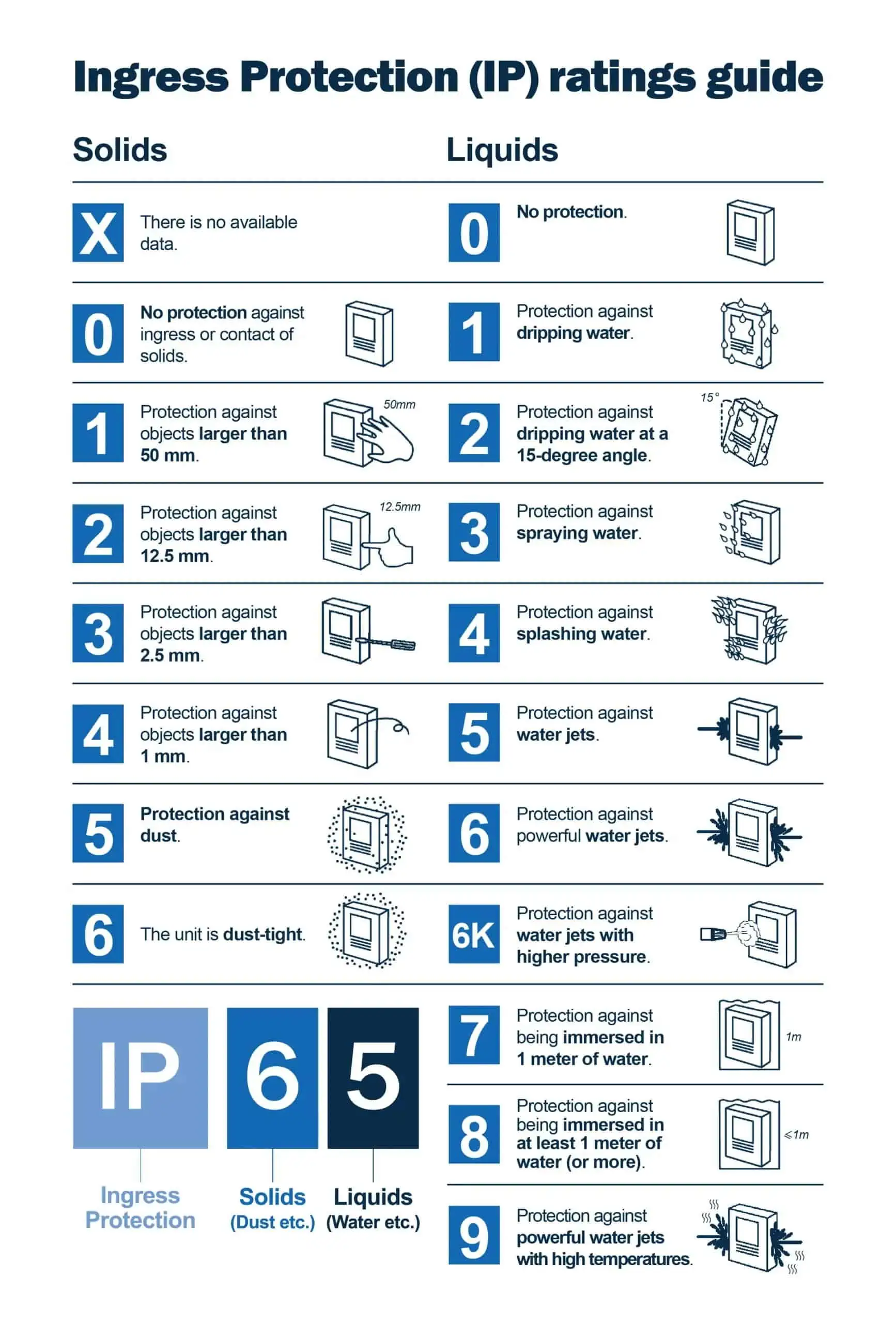
IP Rating Comparison Chart
The below table shows you a comparison between the level of protection for solid and liquid ingress (first and second digit)-
| First Digit | Solid Ingress Protection | Second Digit | Liquid Ingress Protection |
| 0 | No protection | 0 | No protection |
| 1 | Protection from solids bigger than 50mm in diameter | 1 | Protection against vertical water dripping |
| 2 | Protection from the object over 12mm; fingers or similar object | 2 | Protection against vertically dripping water up to 15 degrees from its normal position |
| 3 | Protection from objects larger than 2.5mm in diameter | 3 | Water spray protection up to 60 degrees from a vertical position |
| 4 | Protection against solid objects over 1mm | 4 | Protects from splash weather irrespective of any direction |
| 5 | Partial protection against dust | 5 | Partial water jet protection at low-pressure |
| 6 | Total dust protection | 6 | Protection against strong water jets. |
| N/A | 6K | High-pressure water jet protection | |
| N/A | 7 | Protected in 1m water immersion; test duration is 30 min. | |
| N/A | 8 | Protected for long time water immersion | |
| N/A | 9 | Protection from high temperature, high water pressure, and stream |
What Does IP Rating Measure?
The IP rating measures the degree of protection from three key metrics. These are:
- Resistance to User Ingress:
When using or installing a device, it comes in contact with equipment or the human body. The IP rating measures the level of safety or resistance ability of the device to user contact (accidental or otherwise). For example- IP2X indicates protection against a finger or other similar reference.
- Resistance to Solid Ingress:
The IP rating measures the protection level of a fixture or any device from solid bodies like dust, dirt, etc. The first digit of the IP rating denotes this property of resistance to foreign bodies. For example- IP6X ensures tight protection from any dust particles.
- Resistance to Liquid Ingress:
The second digit of the IP rating measures the capability of an electric device to withstand moisture (liquid). For instance- IPX4 indicates that water splashing from any direction will not harm the appliance.
Thus, with an IP rating, you can know about the resistance level of any device to the user, solid and liquid interference.

Why Have An IP Rating System?
The IP rating clarifies any electrical device’s safety level in adverse environments/weather conditions. With an IP rating, the buyers/customers can be sure about the resistance level of any machine.
When any manufacturer claims a product to be water-resistant or dustproof, it doesn’t specify how much water it can withstand for how many minutes. But by mentioning the IP rating, you can get accurate information about water protection. For example- a fixture with IP67 denotes –
- Complete resistant to dust
- Can be immersed in water for up to 30 minutes (can differ according to manufacturer’s specifications).
So, when purchasing any device, go through the IP ratings to clarify the degree of protection. For instance, if you want to install LED lighting outdoors, you need to remember the adverse weather conditions like- rain, storm, etc. So, a fixture with IP67 or IP68 will work best for robust protection.
Thus, an IP rating system can give you an accurate idea about the safety and protection of a fixator/device. And knowing the IP ratings is essential to get a suitable appliance.
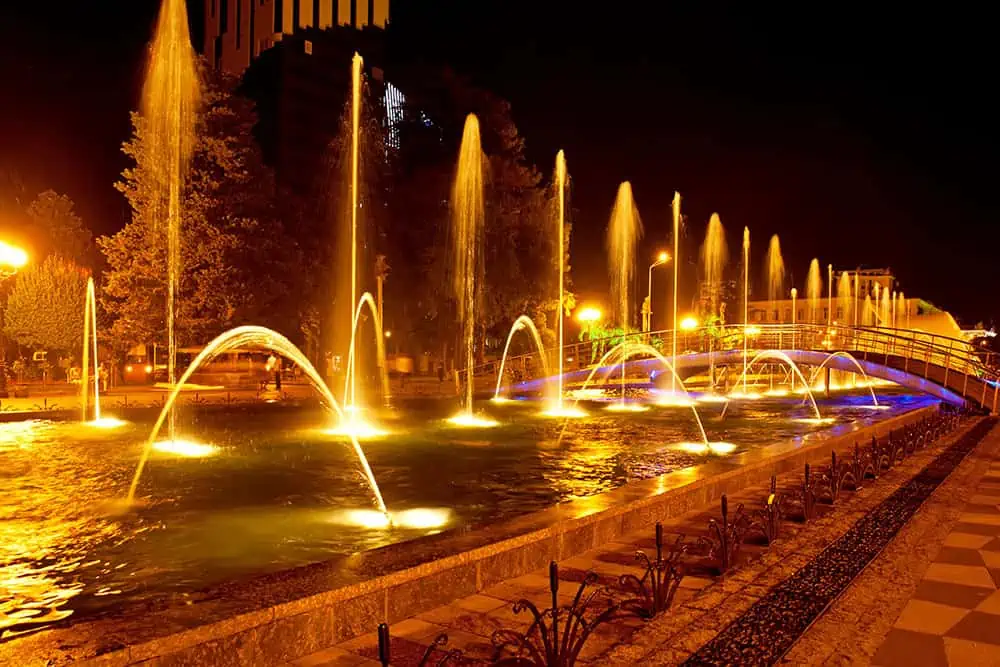
Uses Of IP Rating
IP ratings are used in various devices to denote the ability to protect their internal structure. Here are some of the standard products where which come with IP ratings-
Light Rating
Light fixtures have an IP rating to protect them from dust and water. So, for example, when installing lights outdoors, you must ensure they are dust and water-resistant and can withstand rain and other extreme weather conditions. But again, when you need indoor lighting, it doesn’t require waterproof features.
So, IP ratings of lights vary with the purpose and atmosphere of using them. Here are some ideal ratings for different lighting purposes-
| IP Rating | Appropriate Environment | Type Of Light |
| IP20 & IP40 | Indoors(relatively neutral environment) | LED linear lights, LED strips, etc. |
| IP54 | Indoor(partial dust and water resistant) | Bollard Lights, indoor LED lights, etc. |
| IP65 | Outdoor(tight-dust protected, can withstand rain) | Wall washer light, flex wall washer, bollard lights, LED strips, etc. |
| IP67 & IP68 | Outdoor(can submerge in water; ideal for the pool or fountain lighting) | LED strips, floodlights, etc. |
For more information about waterproof led strip, you can read A Guide to Waterproof LED Strip Lights.
Enclosure
Enclosures are one of the most common items with an IP rating. It can be enclosures of any type, from domestic to industrial uses. However, most of these enclosures are for mechanical or electrical systems—for example- phone housing, instrument case, etc.
Floor Standing Enclosure
Enclosures that stand on the floor quickly get contact with water and insects. That is why the use of IP ratings for such products is essential. And it should have a minimum rating of IP43 for primary protection. With this rating, a floor-standing enclosure can protect itself from tools, wires, and small insects. Besides, it can resist water spray up to 60 degrees from a vertical direction.
Yet, the IP rating of the product depends much on the component placed inside the enclosure. Depending on it, the rating shall go higher; however, IP67 or IP68 work best for secured protection. That is because it ensures tight-dust protection and water resistance and keeps your device safe.
General Purpose Enclosure
General-purpose enclosures are non-specific storage devices that protect an extensive range of electrical equipment. They are highly versatile and have multi-functional electronic storage facilities. Some of them may also have a keypad or lock system.
Usually, the most basic general-purpose enclosure doesn’t have IP ratings. But the ones used for outdoors or industrial purposes have higher IP ratings- IP65 or higher.
Handheld Enclosure
The handheld enclosures are small in size and intended for portability. Therefore, most concentrate more on shielding the device from unintentional damage. That is why they have a lower IP rating. But the ones used outdoors or in wet environments have higher IP ratings.
The enclosures in this category include- a case of voltmeter, digital thermostats, flow readers or heavy-duty phones, etc.
Enclosure Accessories
Besides the enclosures, the accessories used also have an IP rating. And the rating for accessories is vital because they ensure the safety of using them on the enclosure. The accessories include- self-adhesive feet, keypads, locks, nuts, brackets, screws, locks, etc.
Other Product
Besides different types of enclosures, IP rating is used for grading the protection level of many other products. For example- wall boxes, instrument cases, power supply cases, etc.
Therefore, IP rating is prominent in almost every kind of electrical device. And it is also crucial to consider this before purchasing any fixtures or appliances.
Suitable IP Rating For LED Lighting
The IP rating requirements for lights vary depending on the location and purpose of use. As a result, lighting needs specific IP ratings to withstand the environment. Here are some IP ratings for LED lighting that are appropriate for various applications:
Indoor Lighting
Lighting indoors doesn’t face heavy dust or a wet environment, so it doesn’t require a higher IP rating. A minimal rating of IP20 works well indoors. It protects fingers or similar objects. But bathroom lighting needs a higher IP rating to resist moisture.
Bathroom Lighting
When choosing lights for the bathroom, you should be careful with IP ratings as these areas face direct contact with water. Based on this, the bathroom areas can be divided into four zones. The IP requirements for each zone are as follows-
| Zones | Refers To | Ideal IP Rating | Description |
| Zone-0 | Inside Shower OrBath | IP67 | This zone gets submerged in water frequently or temporarily, requiring a water-resistant fixture. |
| Zone-1 | The area directly above the shower or bath(up to 2.25 meters tall) | IP44 or IP65 | The area above the shower remains far from water, so a minimum of IP44 or 65 is enough. |
| Zone-2 | Outside the shower or bath (up to 0.6 meters away) | IP44 | Similar to zone-1, this area remains away from direct moisture contact. |
| Outside The Zones | Any area that doesn’t fall under zone-0,1, and 2. | IP22 (at least) OrIP65 (analyzing contact with moisture) | Areas outside the bathroom zones should have at least an IP22 rating. Yet, experts suggest going for IP65 when installing fixtures for the bathroom. |
So, get a proper idea about your bathroom zones and choose the ideal fixture that is safe for use in the bathroom.
Security Lighting
Security lights are often placed outdoors that face adverse weather conditions; rain, storm, and heavy dust. So, only a fixture with higher IP ratings can withstand such an environment. And for this purpose, you can go for IP44 – IP68 considering the place to install the lighting. But for outdoor uses, IP68 is an ideal choice. It ensures complete dust protection and is waterproof.
Path Lighting
When choosing the ideal fixture for street lighting, consider weather conditions like- dust, wind, and rainwater. A higher IP rating will give rugged protection from street dust and rainfall in these situations. So, choose a fixture with a rating of at least IP65, but IP67 or 68 will be best.
Garden Lighting
In garden lighting, you can go for IP54 or IP65 based on your fixture’s exposure. So, for example, if the light source is more sheltered and doesn’t get direct contact with adverse weather, go for IP54. But if it is more exposed, go for IP65 or higher.
Water-Resistant Lighting
Lighting outdoors, pools or music fountains require water-resistant fixtures. But in choosing the ideal one, you need to know the difference between IP65, IP67, and IP68.
| Water Resistance Limits | IP65 | IP67 | IP68 |
| Resist Water | Yes | Yes | Yes |
| Handle Rain | Yes | Yes | Yes |
| Water Spray | Yes | Yes | Yes |
| Submerge in Water | No | Yes (On 1m depth only and for a short duration) | Yes (Deeper than 1m, stays longer than 10min) |
So, considering these IP rating features, you can get the best water-resistant lights that suit your requirements.
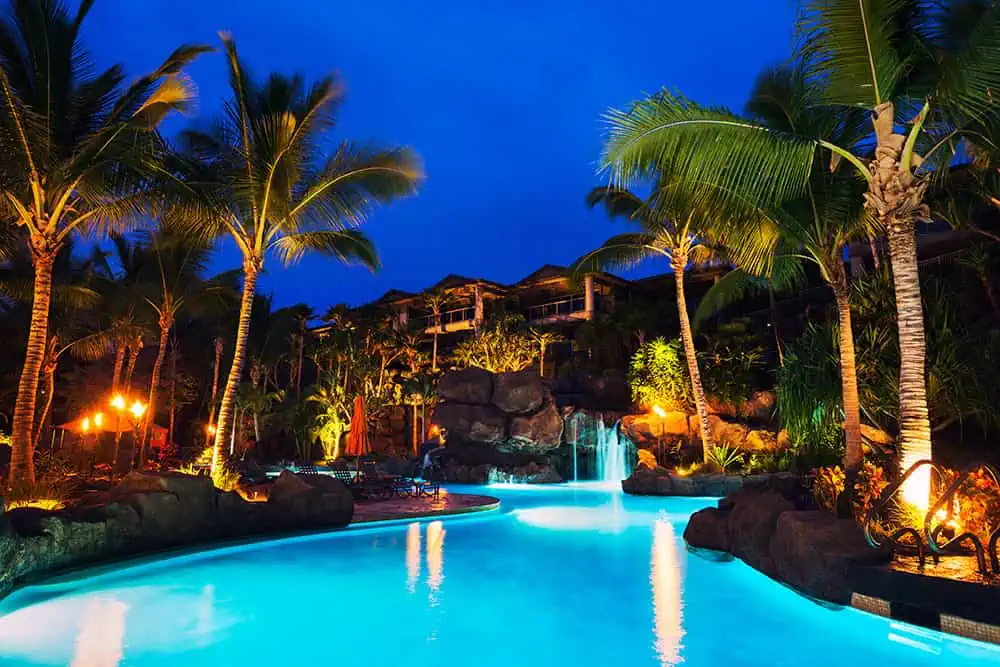
Maximum and Minimum IP Rating For LED Strips
LED strips have a maximum and a minimum IP rating which you should know before purchasing.
Maximum IP Rating For LED Strip: IP68
IP68 is the maximum protection rating for LED strips. The type of protection that a LED strip with IP68 will offer are-
- Tight-Dust Protected: LED strips with an IP68 rating have complete dust protection. So, using them outdoors will not cause the strip any harm related to dust accumulation.
- Water-Proof: A IP68-rated LED strip is waterproof and can submerge in water for more than 30 minutes (can differ according to manufacturer’s specifications).
Thus, with this IP rating, you can use LED strips anywhere; poolside, underwater, bathroom, outdoors, street lighting, wall lighting, etc.
Minimum IP Rating For LED Strip: IP20
A LED strip should have a minimum Ingress Protection rating of IP20. This rating provides LED strip protection from small objects (greater than 12.5 mm), i.e., fingers. But it doesn’t give dust or water protection.
That is why LED strips with an IP20 rating are unsuitable outdoors. Instead, you can use them for indoor lighting areas like- bedrooms, offices, living rooms, etc.
High IP Rating Vs. Low IP Rating
LED strips are available with different IP ratings. And in choosing the ideal rating for your lighting project, you should know the primary difference between higher and lower IP ratings. Here I have presented a general distinction between high and low IP ratings-
- Lower IP ratings are ideal for indoor uses. A higher IP rating can withstand extreme weather conditions. So, it is suitable for outdoors.
- The products/ LED strips with a higher IP rating can resist water with definite limitations. For example- IP67 is water-resistant but doesn’t support continuous submerging in water, but IP68 does. In contrast, fixtures with lower IP ratings are not water resistant/waterproof.
So, go for a lower IP rating if you want to light indoors, house or office. And for outdoor or industrial lighting, go for a higher IP rating with robust protection features.
Why Should You Consider IP Rating When Buying LED Strip?
You can use LED strips both indoors and outdoors. But this suitability depends on its IP rating. Besides this, there are many other reasons to consider the IP rating before buying LED strips. These are-
Assist You In Selecting the Appropriate Fixture
IP rating assists you in choosing a suitable fixture for your lighting project. For example, if you want to light your pool, it requires a submersible LED strip. But all IP ratings with water-resistant strips will not work for lighting pools because all don’t support submerging. For instance- IP68 and IP65 are water resistant, but one can immerse and the other can’t. So, knowing the IP rating will help you to get the ideal one.
Again, if you want to light industrial areas that deal with heavy dust, the IP rating of the LED strip will guide you if it is suitable for that purpose.
Ensure Safety
Electricity and water are always a dangerous combination. So, to ensure safety, it is essential to know if the LED strip is resistant to water. And for that purpose, knowing the IP rating is necessary.
The IP rating gives the exact idea of how much a LED strip is resistant to water. It is not only for water; this rating also ensures whether a fixture can conduct on high-voltage or is dustproof. Thus, the IP rating clarifies the safety of a LED strip.
Specifies Functionality & Durability
IP rating indirectly denotes the functionality and durability of LED strips. But how’s that? Suppose a LED strip with IP68 rating states that it is waterproof and can function in a wet environment. Thus, you can get the idea to choose it for the bathroom, pool lighting, or for outdoors.
Again, you can also know whether the LED strip will be durable in rough weather conditions. For example- a LED strip with IP44 will be stable for indoor use but not a good choice for outdoors. In this way, IP rating can help you to sketch an idea about the functionality and durability of LED strips.
Builds Industrial Standard
IP ratings maintain the same standard globally. In addition, it sets an industrial standard to grade the degree of protection of any electrical device, including LED strips. Thus, IP rating lets you know about the product’s resistance capability. And it also helps you in purchasing fixtures from abroad without worrying about visual testing.
So, for these reasons, as mentioned above, you should consider the IP ratings before purchasing LED strips.
Which Is Better: IP44 or IP65?
The products with IP44 and IP65 ratings ensure protection from user ingress, touch, wires, tool, etc. But still, which one is better? Let’s compare them to find the better one-
- IP65 ensures proper dust protection. But Light fixtures with IP44 are not dust-resistant. So, dust can enter the enclosure causing damage to the item.
- IP44 can’t withstand water jets. In contrast, IP65 provides water jet protection at low-pressure.
Thus, comparing these two ratings, we found IP65 is better as it provides higher protection than IP44.
Which Is Better: IP55 or IP65?
IP55 and IP65 provide an equal degree of protection against liquid ingress. Thus, water jets from any direction will not harm the product with these IP ratings. But they have differences in solid ingress protection.
IP55 is partially protected from dust. That is, there are chances for dust accumulation. In contrast, IP65 ensures complete dust protection. So, IP65 is better than IP55.
Which Is Better: IP55 or IP66?
IP55 and IP66 have different degrees of protection against solid and liquid ingress. Let’s compare these two ratings to find the better one-
- IP55 is dust protected but not entirely; there are chances for dust accumulation. But IP66 is dust-tight. So, no dust can enter the enclosure with IP66 ratings.
- In terms of liquid ingress, IP66 is safer than IP55. IP66 can resist stronger water jets than IP55.
- IP55 can withstand water pressure of 30 kPa and water volume of 12.5 liters/min. In contrast, IP66 can tolerate water pressure up to 100 liters/min at 100 kPa.
Thus, IP66 gives better protection against solid and liquid ingress than IP55.
Which Is Better: IP55 or IPX4?
Go through the following comparison to choose the better one between IP55 and IPX4-
- The letter ‘X’ in the IPX4 rating denotes that the product/ fixture has not been rated for any specific protection level against solid ingress. In contrast, IP55 has ensured protection from solid ingress (dust protected). So, IP55 is a safer choice than IPX4.
- IP55 is resistant to water jets from all directions. Meanwhile, IPX4 is water-splash resistant and can’t withstand water jets.
So, for protection against both solid and liquid ingress, IP55 is a better option than IPX4.
Which Is Better: IP67 or IP68?
You should first know the similarities and dissimilarities between IP67 & IP68 to find the better one. These are as follows-
Similarities Between IP67 & IP68
- Ideal for outdoor uses
- Provides tough-dust protection
- Both can submerge in 1m depth water.
Dissimilarities Between IP67 & IP68
- IP67 is water-resistant (can prevent water entrance to some extent, but not entirely). In contrast, IP68 is waterproof (complete protection from water; water can’t enter).
- A product with IP67 ratings can immerse in the water of 1m depth and withstand only 30 min. Meanwhile, IP68 allows a product/fixture to submerge in more than 1m and last more than 30 minutes, depending on the manufacturer’s specifications.
After analyzing the similarities and differences between IP67 and 68, I find IP68 is better than IP67.
Is IP69 Better Than IP68?
The IP68 and IP69 have the same level of protection against solid ingress. But the difference is visible in terms of protection against liquid ingress.
IP69 is resistant to high temperature, high water pressure, and washout. Therefore, they are ideal for projects that require high sanitization and must tolerate high pressure and hot water cleaning. For example, pharmaceutical applications, chemical manufacturing, food and beverage processing, etc., use IP69 rating devices.
In contrast, IP68 ensures an object’s capability of continuous submerging under manufacture-specified conditions. They can withstand 1m or more deep water for 30 min or more.
Though IP969 is the highest degree for liquid ingress, it is often considered overkill for most applications. On the other hand, IP68 is the most commonly used IP rating for general purposes. Such as rating lights and LED strips; IP68 is used rather than IP69. In contrast, IP69 is used for items that require frequent washouts under high water pressure. So, choosing the better one from IP69 and IP68, you must consider the intent of use.
Is Higher IP Rating Better?
A higher IP rating means better protection from solid and liquid ingress. So, a LED strip/device with high IP ratings can withstand adverse weather conditions like- heavy rainfall, storm, and dust. That is why you can use them anywhere without worrying about damage from bad weather. Moreover, a higher IP rating- IP68 can submerge in water. So, you can use LED strips with this rating for lighting music fountains, pools, bathtubs, etc.
On the other hand, a lower IP rating doesn’t support complete protection from dust and water. So, they are not suitable for adverse weather conditions or outdoors.
To sum up, a higher IP rating gives better security, which is why it is a better option.
Why is IP Water Resistance Important For LED Strips?
IP water resistance is important for LED strips for the following reasons-
Protection From Water Damage
LED strips are used for various purposes, indoors or outdoors. So, it has to go through several challenging atmospheric conditions. And IP water resistance allows it to withstand such an environment.
Besides, IP68 provides complete water protection to LED strips and can be used on submerged areas like pools, bathtubs, artificial fountains, etc.
Outdoor Performance
Water resistance is a must when it comes to outdoor lighting. LED strips with IP water resistance (IP65, 67, and 68) can resist water up to certain limits. For example- IP65 can handle low-pressure water jets, whereas IP67 and IP68 can go well on heavy rail fall conditions.
International Validity
The IP rating is a global standard under International Electrotechnical Commission (IEC) Standard 60529. It is a worldwide recognized system that allows businesses/customers in global markets to select waterproof LED strips confidently.
So, IP water resistance is a crucial factor to consider in selecting LED strips for your project.
What Are IP Waterproof Ratings?
Before knowing the ratings for waterproof, first, understand what exactly waterproof defines. Waterproof means complete protection from water; no water can enter the enclosure. But we often mix the term waterproof with water-resistance (indicating the ability to resist water to some degree, not entirely).
In that sense, IP68 is waterproof and can resist water from entering the enclosure (it can submerge in water as per the manufacturer’s spec). And other ratings – IP65, IP66, IP67 are actually water resistant. They can resist water to some degree but not completely.
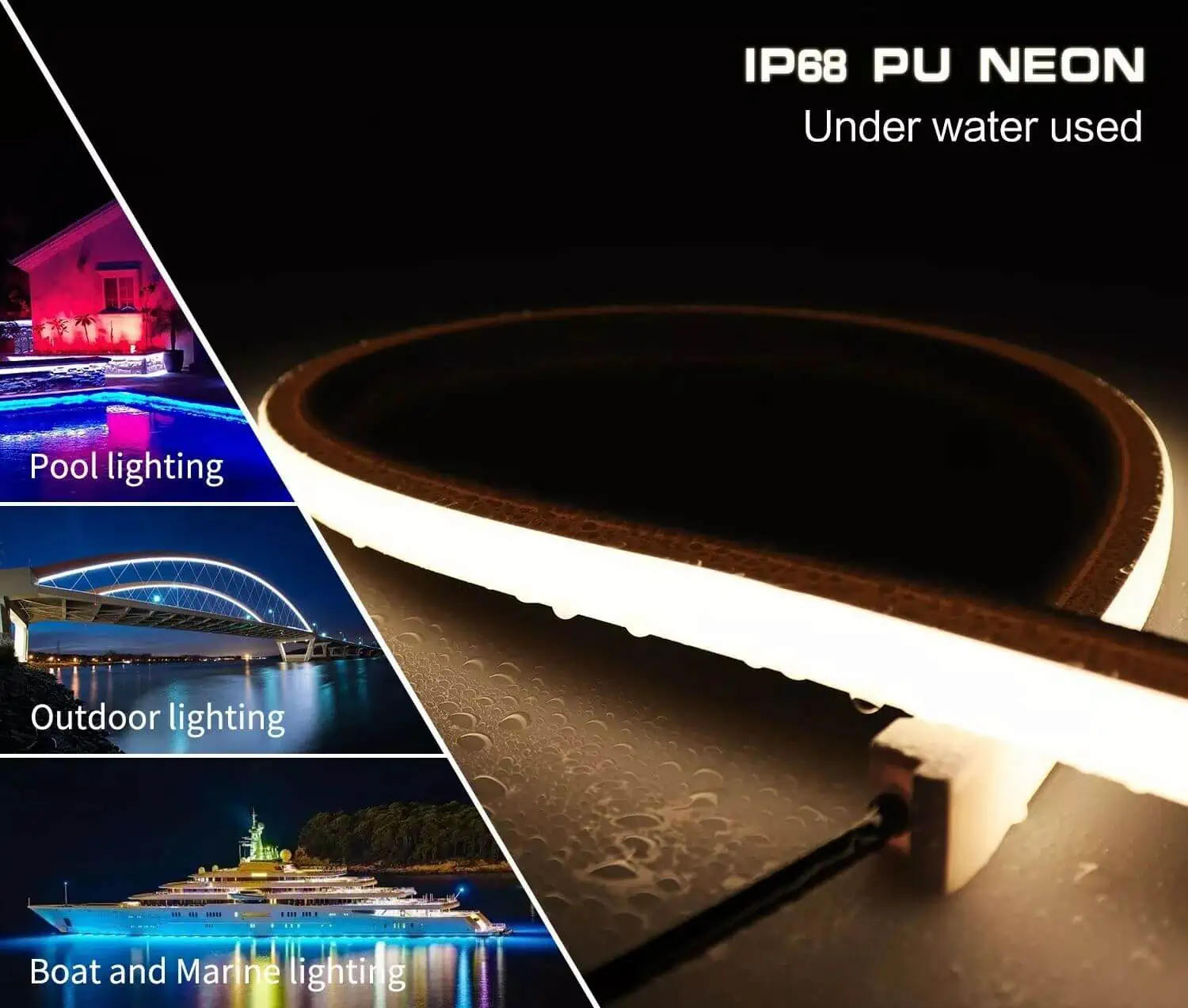
Is It Possible To Have Multiple IP Ratings For A Single Product?
If a unit only has one rating, it means it passed all tests up to and including the number displayed. For example- A LED strip with an IP67 rating means it has passed all lower rating tests along with its IP67 tests.
But sometimes, a single product can have multiple ratings. Like- IP55/IP57 is a multi-IP rating that indicates that the product has passed all the tests up to IP55. It has further passed IP57 tests but failed to pass IPX6. Such ratings are commonly seen on cellular devices.
Another typical example of multi-rating is – IP68M and IP69K. It means that the product has passed both tests.
How IP Ratings Are Tested?
IP rating testing involves various machinery, and different IP ratings must pass several test procedures. Thus, testing IP ratings can be divided into two sections: solid ingress (dust test) and liquid ingress (water test).
Dust-Resistance Testing
Dust testing ensures a product’s safety or resistance level due to dust accumulation. This testing often requires medical and electronic devices that can attract dust.
If the dust test doesn’t interfere with the part’s functionality, it is rated as dust-protected, IP5X. And if the tests result in tight dust protection, the product is rated as IP6X.
Water-Resistant Test
Water-resistant tests concern a product’s ability to withstand water spray, splash, jets, or submersion. For example- An item is tested for IPX4 by subjecting it to an oscillating spray for at least 10 minutes. And the thing passes if there is minimal ingress and no adverse consequences. Similarly, a product gives an IP67 rating when immersed in 1 meter of water for 30 minutes with no harmful effects.
However, several high-tech mercenaries are used to conduct these tests. For example- LEDYi has “IP3-6 Integrated Waterproof Test Chamber” and an “IPX8 Flooding Pressure Testing Machine” for the most accurate water resistance testing of LED strips.

FAQs
The letter ‘X’ in the IP rating indicates that the device has not been tested for any particular ratings or level of protection. Here, X doesn’t mean the product is not resistant to solid or liquid. Rather it indicates the unavailability of information.
IP68 is fully waterproof. It can submerge in more than 1m deep water for 30 minutes or more (as per the manufacturer’s specifications). And water will not harm the enclosure within this period. That is why IP68 is considered fully waterproof.
No, the IP55 rating is not waterproof. Instead, it is water-resistant and can prevent water to some degree, but not entirely.
Though IP55 is not waterproof, it can still resist partial water jets at low-pressure. And as rail falls at low pressure, IP55 is reasonably safe against rain.
IP65 is water-resistant and can withstand rain. In addition, they are dust protected and can resist the water splash of rain.
Yes, IP44 and above have effective rain resistance. The level of rain protection is tested by spraying water from all directions for 5 -10 minutes. And if it passes the test, then it is ok for rain. But for better protection against heavy rain, high IP ratings- IPX5 and IP6 are preferable.
IP68 is waterproof and can submerge under 1m (at least) deep water for 30 min or more. So this rating is safe to use in the shower. Though IP55 is not waterproof, it can provide general protection from water splash/jets. And you can use them in the shower, keeping them away from direct water spray with the shower head.
IP67 dust water resistance up to 1m for 30 mins means- a device or fixture with an IP67 rating will remain harm free when submerged under 1m deep water for 30 minutes.
IP68 is ideal for underwater lighting. It is protected from liquid ingress and can withstand 1m (or more) deep water for 30 min or more. So, you can use light fixtures with IP68 for lighting pools, music fountains, bathtubs, etc.
IP44 outdoor lights are safe to use outside and can withstand rain. But they shouldn’t be exposed to pressurized water, like a jet wash.
IP65 is a good rating for use outside unless it faces extreme weather conditions like a flood. Although this rating gives protection from water jets, they are not submersible.
IP44 is a water-resistant rating but is not waterproof. It can protect an enclosure to some degree but not entirely. For instance- IP44 can resist water splashing (rain) but can not protect from water jets or submersion.
IP68 is waterproof and ensures complete protection against water entrance. Plus, it can submerge in 1m (or more) deep water for 30 minutes (or more per the manufacturer’s specifications). That is why IP68 is ok for swimming.
IP54 is considered ok under the rain as it can resist water splash from all directions. But to withstand heavy rainfall, a higher IP rating is a safer option, i.e., IPX5 or IPX6.
IP68 is not only rainproof but also floodproof. It can submerge in at least 1m deep water and withstand for 30 min or more. So, undoubtedly, it is rainproof.
The IP rating of a device is its ability to protect soil and liquid ingress. With this rating, you can get an idea about the capability of a device to resist dust, water, etc.
IP68 under IEC Standard 60529 means that any device with this rating is dustproof and can immerse in 1m depth water or more. In short, it denotes that the product is dust and waterproof.
IP5X and IP6X provide dust protection. But still, they have differences in the degree of protection. For example, the one with an IP5X rating will partially prevent dust (dust can still enter). But IP6X ensures complete protection from dust; no dust particle can enter the enclosure.
IP68 is the best waterproof rating. Any device with this rating can submerge at least 1m depth for 30 minutes or more (per the manufacturer’s specifications).
IP68 water and dust resistance mean that any device with IP68 can provide tight protection against dust particles. And it can also immerse in water (under manufactured conditions) without causing any harm to the device.
IP55 is protected from dust (not wholly) and low-pressure water jets.
IP69 is the highest IP rating. It provides tight dust protection and resists high temperatures and high pressure of water and stream.

Conclusion
The IP rating is essential for any electric device to ensure protection from solid and liquid ingress. And the same necessity applies to LED strips also.
The IP rating indicates the functionality of a LED strip under rough weather conditions. And thus, it gives you an idea to choose the ideal location for its installation. For example- LED strips with lower IP ratings are suitable for indoor uses, and higher ones for outdoors.
LEDYi provides premium quality LED strips with a wide variation of IP ratings suitable for all lighting purposes. In addition, we have high-tech testing laboratories to ensure accurate IP ratings, including “IP3-6 Integrated Waterproof Test Chamber” and “IPX8 Flooding Pressure Testing Machine”.
Our standard LED strips are available in P20/IP52/IP65/IP67/IP68. Besides, the expert team of LEDYi also meets your customization needs for other IP ratings. So, contact us soon to get the ultimate LED strip lighting solution!
